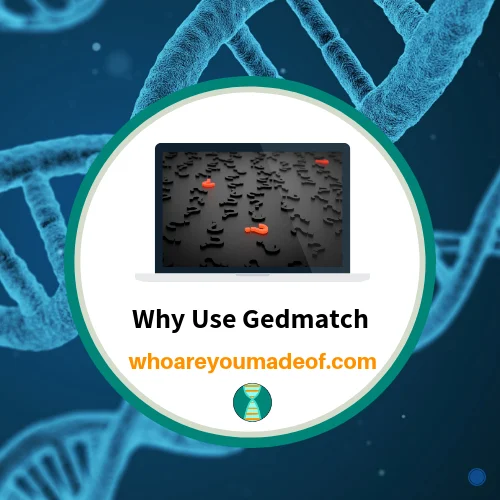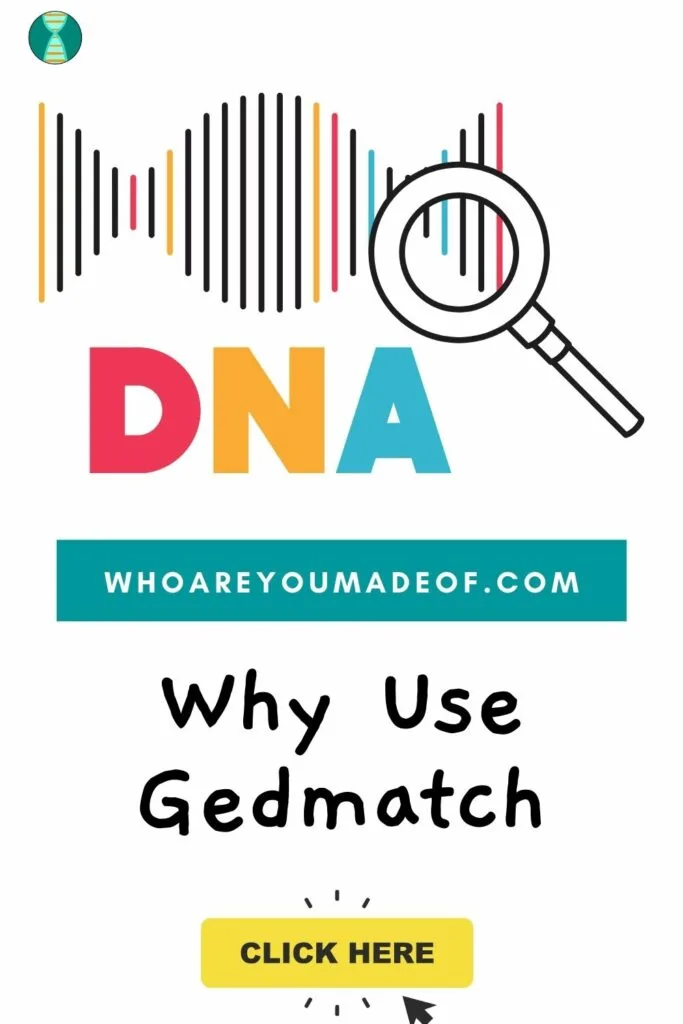Have you heard of Gedmatch? If you have, you might wonder why you should upload your DNA to the site to use the available tools. In other words, why should you use Gedmatch?
In this post, I will outline the top ten reasons that people use Gedmatch. I enjoy using the site, and I feel confident that you will find it helpful, as well.

As it turns out, doing a DNA test is just scratching the surface of how much is possible to learn from your DNA. Keep reading to learn more!
#1 You can find more DNA matches on Gedmatch
By uploading your DNA to Gedmatch, you will be able to access more DNA matches than you can just on your testing company's site. There are several major companies offering DNA testing, which means that your genetic relatives have a lot of choice when they go to test their DNA.
Which company will they choose? Is there any way to find these relatives even if they didn't test with the same company that you did?
Fear not, my fellow DNA tester. This is where Gedmatch comes in handy! Gedmatch (and Gedmatch Genesis) accepts uploads from many different companies, and this means that you'll find DNA matches on the site that you've never seen before.
Maybe you'll find that match that helps you break through a brick wall in your tree, or you'll find the person that you've been searching for?
#2 Compare your DNA at a chromosome level to access data about shared segments
Most people who have tested their DNA have tested with Ancestry DNA. If you are an Ancestry customer, you might have noticed that you only have access to the total amount of shared DNA that you share with a match, and the total number of segments shared.
Through the Ancestry DNA site, you can't see how long the largest segment is, or how long any of the other segments are. Also notable is that you can't see the location of your shared DNA segments.
If you and your DNA matches upload your DNA to Gedmatch, you can easily compare your DNA with your matches using the One-to-One tool, and you'll be able to see:
- Size of all shared DNA segments
- Size of largest segment
- Location and chromosome number of each shared segment
This information can help you figure out how you are related to a match, including how far back in your family tree you might need to look in order to find your connection.
#3 Get a "Second Opinion" ethnicity estimate
Find out if there is something in your DNA that your testing company might have missed by using the "Admixture" tools. There are several different versions of admixture (heritage) calculators that you can use to find traces of ethnicity regions that your testing company didn't report to you.
These calculators were designed by independent researchers and are available to users of Gedmatch for free. You can run your DNA as many times as you want, for free, through as many calculators as you care to use - and it only takes a few seconds to get your results.
#4 Contact your DNA matches directly without having to depend on your testing company's messaging system
Some people never log into their DNA results after the first few times that they check them, and so when you contact them through your testing company's website, there is a chance that they won't see your message. Less frequently, some people report that their testing company's website doesn't work well for delivering messages.
So, why risk your match not seeing your message? On Gedmatch, you can contact them directly using their provided e-mail address.
#5 You can find family trees on Gedmatch
Occasionally, you might find a family tree on Gedmatch that is not available on your testing company's website. Family trees are a great way to figure out how you are connected with someone and can even help you learn more about your own ancestry.
People are permitted - and even encouraged - to upload their family tree to the site.
Who knows what you could learn?
#6 You can adjust the threshold for finding matches on Gedmatch
Every DNA testing company has a specific criteria that they use to determine whether or not two people are a genetic match and might be related to each other. One important part of this criteria is the threshold for the size of the largest DNA segment shared.
It's important to have a threshold, since the smaller a DNA segment, the more likely it is to be a "false" match. With that said, occasionally there might be a legitimate match that falls under the threshold.
On Gedmatch, you can lower the threshold to find those matches with whom you share only very small segments.
I don't usually recommend this for beginners, but if you have a little experience with DNA, you might feel confident playing around with the threshold on your One-to-Many to see who pops up. As a reminder, people who share very small legitimate segments with us will be fairly distant, if not very distant, relatives.
#7 Use segment data for triangulation
On Gedmatch, you can see the exact location on your chromosomes where you match a DNA match, and you can use this data to find other people who match you on that same segment at the same location (or overlapping locations) in order to determine your shared ancestor.
This can help you learn which ancestor gave you a particular DNA segment, as well as help you know where to look in your DNA match's trees to find your connection.
Of course, you can also do this on other DNA testing sites that allow access to a chromosome browser - but you won't find all of the same matches that you will on Gedmatch.
#8 Easily search for people who match you on a particular DNA segment
If there is a particular DNA segment that you are researching, you might be interested to know that there is a tool on Gedmatch (Matching Segment Search) that can help you find all of the people on Gedmatch that match you on that segment.
If you have several matches on that segment, you might find that some of those matches have family trees, either on Gedmatch or another site, and you might be able to learn more about which ancestor passed down that segment to you.
This feature is a Tier 1 tool, which means you have to pay $10 to access it, but it's worth the investment. In fact, I have run this tool on every kit that I manage on the site, and then I print the report to a PDF file that I can access at any point.
#9 Compare your X DNA with your matches
X DNA inheritance can be a little complicated to understand, especially when dealing with distant X DNA matches. With close matches, however, X DNA can be the key in figuring out how you are related, or how you are NOT related.
Gedmatch allows for easy comparison of X DNA with the "X DNA One-to-One" tool.
#10 Gedmatch has some "fun" tools that can also be useful
Do you want to know if your parents were related? Are you interested in whether or not your eye color can be predicted simply by looking at your DNA information? Gedmatch has got your back!
The "Are Your Parents Related?" tool can tell you if you have matching segments on both copies of a chromosome, implying that your parents have a common ancestor. If Gedmatch does find evidence that your parents might be related, it will also give you an estimated distant of their relationship (which is, of course, a very loose estimation).
This tool can be useful if you keep finding matches that match both of your parents - this tool might give you some insight as to why.
The eye color tool isn't really useful for genealogy research, but it is a lot of fun 🙂
Conclusion
I hope that you have enjoyed this post, and that it has helped give you some insight into some reasons that you should definitely use Gedmatch. If you have any questions about this list, or would like to add a reason to use Gedmatch that I didn't include here, I'd love to hear from you in the discussion below.
Thanks for stopping by!


